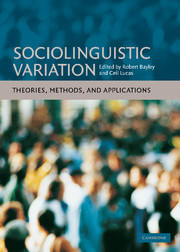Book contents
- Frontmatter
- Contents
- 1 List of figures
- 2 List of tables
- Acknowledgments
- Notes on editors and contributors
- Introduction
- Part 1 THEORIES
- 1 Variation and phonological theory
- 2 Syntactic variation
- 3 The psycholinguistic unity of inherent variability: old Occam whips out his razor
- 4 The study of variation in historical perspective
- 5 Style in dialogue: Bakhtin and sociolinguistic theory
- 6 Variation and historical linguistics
- 7 Second language acquisition: a variationist perspective
- 8 Variation and modality
- Part 2 METHODS
- Part 3 APPLICATIONS
- Afterword: Walt Wolfram and the study of sociolinguistic variation
- References
- Index
1 - Variation and phonological theory
Published online by Cambridge University Press: 16 February 2010
- Frontmatter
- Contents
- 1 List of figures
- 2 List of tables
- Acknowledgments
- Notes on editors and contributors
- Introduction
- Part 1 THEORIES
- 1 Variation and phonological theory
- 2 Syntactic variation
- 3 The psycholinguistic unity of inherent variability: old Occam whips out his razor
- 4 The study of variation in historical perspective
- 5 Style in dialogue: Bakhtin and sociolinguistic theory
- 6 Variation and historical linguistics
- 7 Second language acquisition: a variationist perspective
- 8 Variation and modality
- Part 2 METHODS
- Part 3 APPLICATIONS
- Afterword: Walt Wolfram and the study of sociolinguistic variation
- References
- Index
Summary
Introduction
The study of linguistic variation is often perceived to be quintessentially engaged with phonological phenomena. This is a manifest misperception: variationist work on morphosyntactic issues began with the original foundational articles that launched the “variable rule” framework (Labov [1969] on the English copula, and Labov [1972d] on negative concord), and continues to be among the most active areas in the field. But it is instructive to consider why such a misperception persists. There are two factors that drive this view. First, there exists an almost prescriptive attitude that phonology is the only domain in which linguists should speak of variation, arising from an uneasy suspicion that any alternations found at other levels of linguistic structure might involve intentional differences in meaning. In Labov's informal definition, variation involves “different ways of saying the same thing,” and for most linguists it is easy to conclude that runnin' and running are different versions of the “same thing,” but rather worrisome to make the same claim about Kyle got arrested and Kyle was arrested. Hence the view that variationists tidily confine their labors to the vineyard of phonology alleviates this existential angst about the status of morphosyntactic variation.
But a second, more interesting, reason for this view is that it is indeed quite true that work on phonological variation has been deeply intertwined with phonological theory. Phonological variation in all languages is massively structured and orderly; there is a random component, such that the surface realization of a given utterance cannot be predicted categorically, but the patterns of realizations in particular contexts are probabilistically structured with great regularity – particular realizations are strongly favored by particular phonological contexts.
- Type
- Chapter
- Information
- Sociolinguistic VariationTheories, Methods, and Applications, pp. 5 - 23Publisher: Cambridge University PressPrint publication year: 2007
- 4
- Cited by



